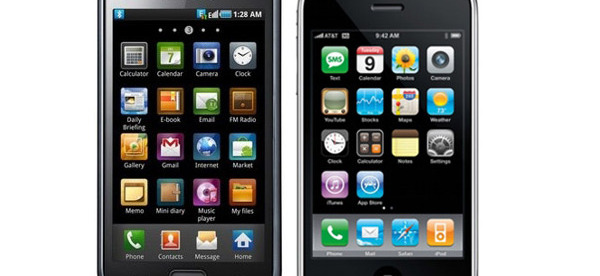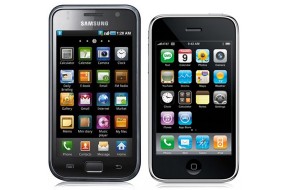An Apple Lawsuit a Day Keeps Infringement Away

Nowadays, it seems like Apple, the maker of the all-popular iPhone and iPad, is always wrapped up in a lawsuit against another company over a patent. If that is the case, then why was the most recent lawsuit such a big deal? To sum up the latest legal battle, Apple sued Samsung over six patents—alleging that Samsung had infringed on those patents by copying designs from the iPhone and iPad.
What was strikingly different about this lawsuit was the type of patent sued upon. Generally, when Apple was suing or being sued, it was on a “utility patent,” or due to a copyright. For example, when Apple sued Microsoft in 1994, it was due to Microsoft’s infringement of an Apple copyright. When Apple sued HTC in 2010, it was due to infringements on twenty Apple utility patents.
A utility patent is issued for something that performs a function in a novel way and, in most cases, these were Apple’s software patents on the iPhone. The way you swipe your finger to unlock an iPhone? Utility patent. The way that the screen “bounces back” once you’ve scrolled to the bottom and nothing is left? Utility patent. These are different from what is called a “design patent.” Now, a design patent is issued for the look of the thing. It has nothing to do with how the underlying device functions; it’s all based on “ornamental reasons.” This brings us to why this lawsuit is different.
In the past, Apple had rarely, if at all, sued upon their design patents. This time, half of the patents they sued on were design patents. Bluntly put, Apple sued Samsung because Samsung’s phones looked like Apple’s phones. The real nuance in the case lies in the damages.
Damages awarded for utility patent infringement are royalties that would have been paid for that utility patent, or “damages adequate to compensate for that infringement.” Either way, the damages relate specifically to the function of the utility patent. However, for design patent infringement, the infringer is liable for total profit that the owner has lost because of the infringement. As you can imagine, this is incredibly difficult to determine and sets a very high ceiling for damages in design patent infringement lawsuits. Perhaps it was because of the possibility for unlimited damages, and the difficulty and/or arbitrariness of obtaining the damage number that led the jury in Apple v. Samsung to reach its $1.05 billion verdict (if it stands, it will be the largest patent verdict in US history) for Apple in only three days of deliberation..
What does this design patent ruling mean for everyone that isn’t Apple or Samsung? The reaction has been mixed. On one hand, the limitation on designing something that looks like an iPhone might lead to more creative and innovative designs that might even work better. On the other hand, the limitation on design might be so stifling that Apple might have come close to creating a design monopoly. For small businesses and product designers, the verdict means they must be more cautious about creating something that even looks very similar to another product.
Moreover, Apple v. Samsung may open floodgates for other lawsuits based on design patents. But how closely alike does an allegedly infringing design have to be in order for remedies? This remains unclear, and the courts will have to parse their way through the facts in specific cases until the Supreme Court takes a hard look at the question.
If the case stands, you can bet that Apple will have significant leverage to attack other mobile companies based on their design patents. You can also bet that Samsung’s lawyers are throwing everything they have at getting this decision overturned. Until then, an Apple lawsuit a day not only keeps infringement away, but it also keeps Google at bay.


This is a very well written and informative article. You made it very clear to understand, even though I know nothing of patent laws. Keep it up!
If this verdict stands, it will force all other companies to perform at a much higher level to push the tech design frontier, but it could stifle companies with less resources; it could intensify the polarization of the have’s and have-not’s and facilitate monoply. The question is will the government be ready to break it up as it did with Bell?
It is going to be interesting to see how the iPhone 5 will affect this situation. With a new model comes new patents, which means more opportunity for infringement! It’s also interesting to examine the role of juries in this type of complicated patent litigation. These are basically lay people, likely with no technical expertise at all, who have to listen to hours and hours of explanations of how these phones are mechanized in similar ways. At a certain point, I think people must think, “Hey, I like Apple. They’re American. They have a patent! How dare Samsung try to steal their ideas. I love my iPhone.” End of case.
I think this decision will really push designers to be more innovative. If companies are guaranteed that the aesthetic of their great new products cannot be imitated, they may be more willing to throw a lot more money towards product design and development. Nobody wants to spend millions of dollars coming up with a great design if they know that someone else can just come along and copy it. I hear a lot of people saying things like “Apple gets to claim rounded corners? That’s ridiculous.” Yeah, well no matter what most of us say about Apple’s new a6 chip and faster beta-whatevers, we buy iPhones because they look great. They are sleek, simple, and clean. Those rounded corners were thoughtful and innovative, and they contribute to the overall look and feel of a great product. I am a huge fan of companies being able protect their designs. If you don’t like it, then design something better, patent it, and laugh when Apple doesn’t get to use your design.
I have doubts as to whether design patents are actually constitutional. They probably aren’t. Government-granted monopolies are rarely a good idea in any case, even if they are Constitutional.